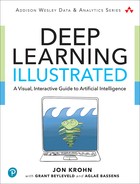Examples
5.1 Software dependencies for shallow net in Keras
5.2 Loading MNIST data
5.3 Flattening two-dimensional images to one dimension
5.4 Converting pixel integers to floats
5.5 Converting integer labels to one-hot
5.6 Keras code to architect a shallow neural network
5.7 Keras code to train our shallow neural network
8.1 Keras code to architect an intermediate-depth neural network
8.2 Keras code to compile our intermediate-depth neural network
8.3 Keras code to train our intermediate-depth neural network
9.1 Weight initialization with values sampled from standard normal distribution
9.2 Architecture for a single dense layer of sigmoid neurons
9.3 Weight initialization with values sampled from Glorot normal distribution
9.4 Additional dependencies for deep net in Keras
9.5 Deep net in Keras model architecture
9.6 Deep net in Keras model compilation
9.7 Regression model dependencies
9.8 Regression model network architecture
9.9 Compiling a regression model
9.10 Fitting a regression model
9.11 Predicting the median house price in a particular suburb of Boston
9.12 Using TensorBoard while fitting a model in Keras
10.1 Dependencies for LeNet in Keras
10.2 Retaining two-dimensional image shape
10.3 CNN model inspired by LeNet-5
10.4 CNN model inspired by AlexNet
10.5 CNN model inspired by VGGNet
10.6 Loading the VGGNet19 model for transfer learning
10.7 Adding classification layers to transfer-learning model
10.8 Defining data generators
10.9 Train transfer-learning model
11.1 Converting a sentence to lowercase
11.2 Removing stop words and punctuation with a list comprehension
11.3 Adding word stemming to our list comprehension
11.4 Detecting collocated bigrams
11.5 Removing capitalization and punctuation from Project Gutenberg corpus
11.6 Detecting collocated bigrams with more conservative thresholds
11.7 Creating a “clean” corpus that includes bigrams
11.8 Running word2vec
11.9 t-SNE for dimensionality reduction
11.10 Static two-dimensional scatterplot of word-vector space
11.11 Interactive bokeh plot of two-dimensional word-vector data
11.12 Loading sentiment classifier dependencies
11.13 Setting dense sentiment classifier hyperparameters
11.14 Loading IMDb film review data
11.15 Printing the number of tokens in six reviews
11.16 Printing a review as a character string
11.17 Print full review as character string
11.18 Standardizing input length by padding and truncating
11.19 Dense sentiment classifier architecture
11.20 Compiling our sentiment classifier
11.21 Creating an object and directory for checkpointing model parameters after each epoch
11.22 Fitting our sentiment classifier
11.23 Loading model parameters
11.24 Predicting ŷ for all validation data
11.25 Printing a full validation review
11.26 Plotting a histogram of validation data ŷ values
11.27 Calculating ROC AUC for validation data
11.28 Creating a ydf DataFrame of y and ŷ values
11.29 Ten cases of negative validation reviews with high ŷ scores
11.30 Ten cases of positive validation reviews with low ŷ scores
11.31 Additional CNN dependencies
11.32 Convolutional sentiment classifier hyperparameters
11.33 Convolutional sentiment classifier architecture
11.34 RNN sentiment classifier hyperparameters
11.35 RNN sentiment classifier architecture
11.36 LSTM sentiment classifier hyperparameters
11.37 LSTM sentiment classifier architecture
11.38 Bidirectional LSTM sentiment classifier architecture
11.39 Stacked recurrent model architecture
11.40 Multi-ConvNet sentiment classifier hyperparameters
11.41 Multi-ConvNet sentiment classifier architecture
12.1 Generative adversarial network dependencies
12.2 Loading the Quick, Draw! data
12.3 Discriminator model architecture
12.4 Compiling the discriminator network
12.5 Generator model architecture
12.6 Adversarial model architecture
12.7 Compiling the adversarial network
12.8 GAN training
12.9 Plotting our GAN training loss
12.10 Plotting our GAN training accuracy
13.1 Cart-Pole DQN hyperparameters
13.2 A deep Q-learning agent
13.3 DQN agent interacting with an OpenAI Gym environment
14.1 Dependencies for building a Keras layer-based deep net in TensorFlow without loading the Keras library
